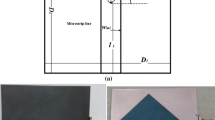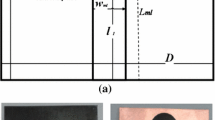Abstract
In the present paper, a compact defected ground plane antenna is analyzed with respect to its modal behavior. Two open-ended slots along with a ground slot give dual-band response. The optimum dimensions of the two slots on patch realize dual-band response suitable for IEEE 802.11 WLAN application. Ground slot decides the coupling between the two bands. The two bands operating at the center frequencies 5.25 and 5.7 GHz are due to TM11 and TM21 modes of the patch, respectively. The slots being orthogonal to TM11 and TM21 modes modify the current distribution of patch at these modes and cause increase in the current path length. Thus, the said modal frequencies are reduced with reference to fundamental TM01 mode frequency. The results obtained are nearly same as experimentally reported results. The gain noted is approximately 2 and 2.5 dBi, respectively, at the two bands. Radiation patterns at both bands are toward broadside direction with E-plane aligned alongside Φ = 0° and H-plane along 90°.
Access provided by Autonomous University of Puebla. Download conference paper PDF
Similar content being viewed by others
Keywords
1 Introduction
The modern wireless devices support multiple applications operating at varied frequency bands, thereby increasing the demands of compact multiband antennas. The microstrip antenna being low volume and conformal is the most suitable choice for wireless applications [1]. Multiband response is obtained when the frequencies of higher-order modes are brought down so that they lie closer to TM01 fundamental mode frequency. The coupling among these modes is adjusted which forms large-size loop; thus, loop is not realized inside VSWR 2 circle. Moreover, radiation pattern at resonant frequency of all resonant modes responsible for realizing multiband response must be stable and similar. Various methods have been introduced in past to achieve dual-band response in microstrip antennas which include stub loading, gap-coupled techniques, etc. In [2], dual- and triple-band antennas are realized using stub loading technique. These antennas are realized with disadvantage of size. Paper [3] covers stub loaded microstrip antenna configurations for broadband response. However, the broadband response is achieved at the cost of antenna size. The dual-frequency response with large frequency ratio of 2.0–4.9 is achieved in paper [4] using single feed and shorting pin loading technique. It is shown that by changing the position of shorting pin the two operating resonant frequency ratio can be tuned. Another widely used technique to achieve multiple-band response is by introducing slots either on patch or on ground plane of microstrip antenna. Slot cut at appropriate position on patch modifies the surface current distribution on patch, thereby increasing current length which leads to frequency reduction and hence the size reduction of the antenna. Paper [5] presents microstrip patch antenna designed for dual-frequency operations by embedding two asymmetric U-shaped slots. Nowadays, modified or defected ground structures are gaining popularity as it gives multiband response and also leads to compactness [6,7,8,9,10]. The microstrip antenna is equivalent to a parallel plate capacitor, wherein two plates are linked to each other through the fringing fields. Thus, any modifications on the antenna ground plane are reflected on the patch as well. The slots cut on the ground plane can thus aid in achieving multiband response along with the patch size reduction. Although a number of publications describe defected ground plane antennas, not many papers explain the antenna configurations from design process perspective. Moreover, modal analysis which is important to know so as to understand the antenna behavior after embedding one or multiple slots on the antenna ground plane is lacking in papers reported in the past.
In the current paper, a compact dual-band defected ground structure (DGS) patch antenna is realized by cutting one or multiple slots on patch and/or ground plane. Antennas’ higher-order resonant mode frequencies are altered and pulled nearer to fundamental TM01 mode frequency, so they together yield dual-band response. Thorough investigation of resonant modes of presented antenna is discussed in paper. Two resonant peaks are detected which are because of TM11 and TM21 modes, respectively, at center frequencies 5.25, 5.7 GHz. TM11 and TM21 modes are spaced in optimum way in order to yield dual-band response.
2 Reported Compact Dual-Band Defected Ground MSA
The geometry of the antenna reported in paper [5] is depicted in Fig. 1a. Two open-ended rectangular slots are etched on rectangular patch of size 12 mm × 8 mm backed by a finite ground plane of dimension 24 mm × 16 mm. A rectangular slot is introduced on antenna ground plane which is oriented along radiating edges of the patch. Antenna is realized using glass epoxy substrate having following parameters: dielectric constant: 4.2, loss tangent: 0.02, and substrate thickness: 1.6 mm. The patch is excited at (0, −3.3) using coaxial feed. The S11 plot for the antenna is depicted in Fig. 1b. Lower resonant mode frequency is due to the slot L1, and the upper resonant frequency is due to slot L2; the coupling between them is decided by the ground slot. The area reduction of 53.73% is obtained.
a Geometry of antenna with the side view b S11 plot [6]
The plots for resonance curve and current distribution of optimized antenna are displayed in Fig. 2a–c. Two resonant peaks are observed in the resonance plot giving dual-band response obtained at center frequency of 5.2 and 5.87 GHz, respectively. Radiation patterns viewed at two observed resonant frequencies are in broadside direction having their E-plane aligned along Φ = 0°. The gain attained at first band is 2 dBi and at second band is 2.5 dBi. Glass epoxy substrate material having 4.2 permittivity (εr) and 0.02 loss tangent is used for antenna fabrication. The substrate is 1.6 mm thick. Designed microstrip antenna operates at two bands of frequencies, namely 5.125–5.395 and 5.725–5.985 GHz to support IEEE802.11a WLAN. The results obtained on simulation when compared with reported data show close similarity between them.
3 Analysis of Compact Dual-Band Defected Ground MSA
In order to analyze the antenna, an equivalent antenna without any slot is simulated using simulation software (IE3D) keeping the feed point location same as in the reported paper so as to check the modes getting excited. The modes of a patch for a given feed point location are fixed, and once the slots are introduced on the patch or ground, it modifies the current path length and thus leads to shifting of resonant mode frequencies. The equivalent antenna resonates at 6.2 GHz fundamental TM01 mode frequency followed by TM20 mode frequency at 10.5 GHz frequency as clearly evident from surface current distribution depicted in Fig. 3a, b.
The subsequent higher-order mode frequency corresponds to TM21 mode that shows two half cycle sinusoidal variations lengthwise of patch and one half cycle sinusoidal variation alongside width of patch. An open-ended rectangular slot L1 is cut orthogonal to horizontal surface current of the patch, thus affecting TM01 and TM11 modes significantly. Parametric study was performed on L1 parameter to see the result of this slot on the resonant modes. Since TM20 mode currents are oriented along the slot, its frequency does not vary with respect to change in this slot length. For the increase in slot length, the TM11 modal frequency shifts to lower value, while TM20 modal frequency has no variation as depicted in Fig. 4a. Distribution of current on the patch when the slot length is set to 6 mm is observed for various resonant frequencies and is depicted in Fig. 4b–d.
For larger slot length, the resonant mode TM21 goes lower than the TM20 mode frequency. Another horizontal slot is etched on the patch which further reduces the TM11 mode frequency. These slots increase the current path length for this mode and hence bring the frequency down. However, the impedance at this mode also decreases which imposes a limit on length of the slot length as depicted in Fig. 5a. Now, an additional horizontal slot is cut on antennas ground plane beneath the patch. This slot further reduces TM21 mode frequency.
The ground slot enables appropriate coupling between the TM11 and TM21 mode frequencies so that these modes lie within VSWR 2 circle to realize dual-band response as presented in Fig. 5b, c. Also, this slot modifies the surface current orientation of the patch resulting in unidirectional current flow. The slots being orthogonal to TM11 and TM21 modes modify the distribution of current on patch at these modes and result in increase in the current path length. Thus, the said mode frequencies are reduced and are pushed toward the fundamental mode frequency. Thus, a dual-band response is realized.
4 Result and Conclusions
The antenna designed operates at two bands of frequency, namely 5.125–5.395 and 5.725–5.985 GHz, to support IEEE802.11a WLAN application. Figure 6a depicts the S11 plot of the optimized MSA antenna. Two open-ended slots and the ground slot together yield a dual-band response. The slots being orthogonal to TM11 and TM21 modes disturb the distribution of current on the patch at these modes and thereby lead to increase in the current path length. Thus, the said modal frequencies are reduced with respect to the fundamental mode frequency.
Two resonant peaks are detected on the resonance plot which are because of TM11 and TM21 modes, respectively, at 5.25, 5.7 GHz frequencies with the −10 dB impedance bandwidth of 0.39 GHz (7.4%) and 0.24 GHz (4.09%), respectively. The antenna yields broadside radiation pattern at both resonant mode frequencies with E its plane aligned alongside Φ = 0° as depicted in Fig. 5c, d. The gains found at the two bands are 2 and 2.5 dBi, respectively, as shown in Fig. 6b. Thus, comprehensive investigation of the reported paper is carried out in this paper.
References
Antar Y, Guha D (2010) Microstrip and printed antennas: new trends, Techniques and applications. Wiley, New York, USA
Deshmukh AA, Ray KP (2010) Multi-band configurations of stub-loaded slotted rectangular microstrip antennas. IEEE Antennas Propoag Mag
Aanandan CK, Mohanan P, Nair KG (1990) Broad-band gap coupled microstrip antenna. IEEE Trans Antennas Propag 1581–1586
Pan SC, Wong KL (1998) Design of dual-frequency microstrip antennas using a shorting-pin loading. In: Institute of electrical and electronics engineers
Bhalla R, Shafai L (2001) Resonance behavior of single U-slot and dual U-slot antenna. In: Institute of electrical and electronics engineers
Chakraborty U, Kundu A, Chowdhury SK, Bhattacharjee AK (2014) Compact dual-band microstrip antenna for IEEE 802.11 a WLAN application. IEEE Antenna Propag Lett 13
Elftouh H, Touhami NA, Aghoutane M, El Amrani S, Tazón Puente A, Boussouis M (2014) Miniaturized microstrip patch antenna with defected ground structure. Progress Electromagenetic Res 55
Shaif ADSS, Selçuk S, Kabadayı G, Toraman Ö, İmeci ŞT (2017) Diamond-shaped microstrip patch antenna with defected ground structure. In: Institute of electrical and electronics engineers
Truong LX, Tao VQ, Tuan TM, Giang TVB (2015) Design a microstrip antenna with defected ground structure. In: Institute of electrical and electronics engineers
Konkyana FALB, Sudhakar BA (2019) A review on microstrip antennas with defected ground structure techniques for ultra-wideband applications. In: Institute of electrical and electronics engineers
Author information
Authors and Affiliations
Corresponding author
Editor information
Editors and Affiliations
Rights and permissions
Copyright information
© 2020 Springer Nature Singapore Pte Ltd.
About this paper
Cite this paper
Kadam, P., Deshmukh, A.A. (2020). Analysis of Compact Dual Band Defected Ground Microstrip Patch Antenna for WLAN Application. In: Vasudevan, H., Gajic, Z., Deshmukh, A. (eds) Proceedings of International Conference on Wireless Communication . Lecture Notes on Data Engineering and Communications Technologies, vol 36. Springer, Singapore. https://doi.org/10.1007/978-981-15-1002-1_3
Download citation
DOI: https://doi.org/10.1007/978-981-15-1002-1_3
Published:
Publisher Name: Springer, Singapore
Print ISBN: 978-981-15-1001-4
Online ISBN: 978-981-15-1002-1
eBook Packages: EngineeringEngineering (R0)










